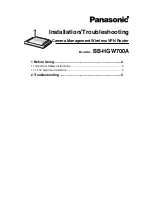
Appendix C
Common Questions
©
National Instruments Corporation
C-7
Table C-1 corresponds the hardware signal names to the software signal
names in LabVIEW and NI-DAQ.
What are the power-on states of the PFI and DIO lines on the I/O
connector?
At system power-on and reset, both the PFI and DIO lines are set to
high-impedance by the hardware. This setting means that the device
circuitry is not actively driving the output either high or low. However,
these lines may have pull-up or pull-down resistors connected to them as
shown in Table 4-3,
I/O Signal Summary for the NI 6013/6014
. These
resistors weakly pull the output to either a logic-high or logic-low state.
For example, DIO<0> is in the high-impedance state after power on, and
Table 4-3,
I/O Signal Summary for the NI 6013/6014
, shows the 1.5 k
Ω
pull-down resistor. This pull-down resistor sets the DIO<0> pin to a logic
low when the output is in a high-impedance state.
Table C-1.
Signal Name Equivalencies
Hardware
Signal Name
LabVIEW
Route Signal
NI-DAQ Select_Signal
TRIG1
AI Start Trigger
ND_IN_START_TRIGGER
TRIG2
AI Stop Trigger
ND_IN_STOP_TRIGGER
STARTSCAN
AI Scan Start
ND_IN_SCAN_START
SISOURCE
—
ND_IN_SCAN_CLOCK_TIMEBASE
CONVERT*
AI Convert
ND_IN_CONVERT
AIGATE
—
ND_IN_EXTERNAL_GATE
WFTRIG
AO Start Trigger
ND_OUT_START_TRIGGER
UPDATE*
AO Update
ND_OUT_UPDATE
UISOURCE
—
ND_OUT_UPDATE_CLOCK_TIMEBASE
AOGATE
—
ND_OUT_EXTERNAL_GATE
















































